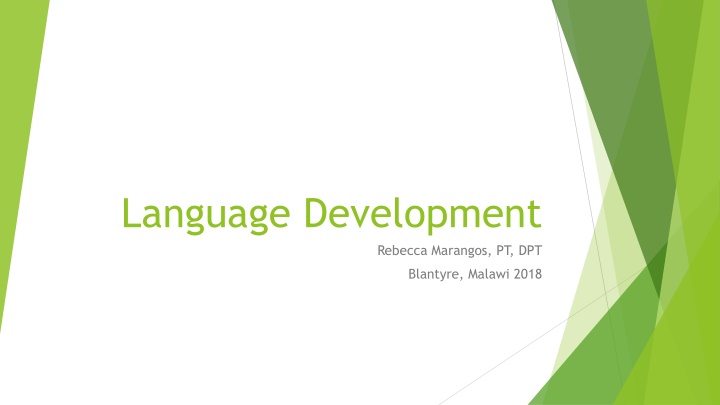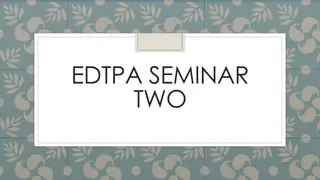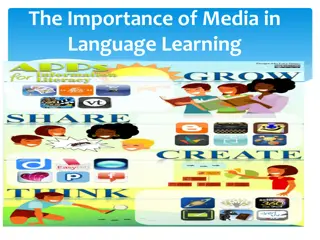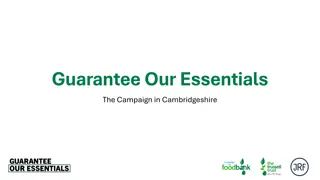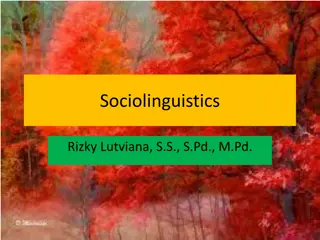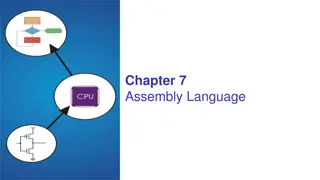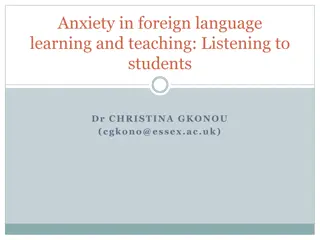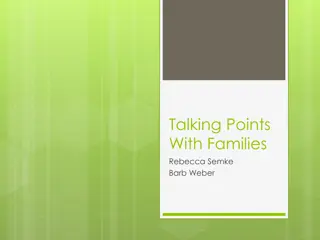Language Development Essentials
The properties, processes, and acquisition of language, along with fundamental aspects such as speech and phonetics. Discover how language development unfolds in infants, from hearing and understanding to early speech milestones.
Download Presentation

Please find below an Image/Link to download the presentation.
The content on the website is provided AS IS for your information and personal use only. It may not be sold, licensed, or shared on other websites without obtaining consent from the author.If you encounter any issues during the download, it is possible that the publisher has removed the file from their server.
You are allowed to download the files provided on this website for personal or commercial use, subject to the condition that they are used lawfully. All files are the property of their respective owners.
The content on the website is provided AS IS for your information and personal use only. It may not be sold, licensed, or shared on other websites without obtaining consent from the author.
E N D
Presentation Transcript
Language Development Rebecca Marangos, PT, DPT Blantyre, Malawi 2018
Objectives Identify the properties that characterize language Be able to state the processes involved in language Describe how we acquire the ability to use language
Definitions Language Communication Psycholinguistics Linguistics Neurolinguistics Sociolinguistics
Properties of Language Communication Arbitrarily symbolic Regularly structured Structured at multiple levels Generative, productive Dynamic
Fundamental Aspects of Language Receptive Expressive Encoding
Fundamental Aspects Speech Phone Phoneme Allophone Morpheme Language Lexicon Syntax Semantics Discourse
Language and The Brain Broca s area Controls speech Wernicke s area Language understanding Motor Cortex Oral motor deficits
Development of Language Infants appear to be preprogrammed to learn phonemes, but need years to learn the rules Children are able to discriminate among different sounds which correspond to different phonemes in any language
Hearing and Understanding Birth 3 Months Startles to loud sounds Quiets or smiles when spoken to Seems to recognize your voice and quiets if crying Increases or decreases sucking behavior in response to sound 4 6 Months Moves eyes in direction of sounds Responds to changes in tone of your voice Notices toys that make sounds Pays attention to music Talking Birth 3 Months Makes pleasure sounds (cooing, gooing) Cries differently for different needs Smiles when sees you The First Year 4 6 Months Babbling sounds more speech-like with many different sounds, including p, b and m Chuckles and laughs Vocalizes excitement and displeasure Makes gurgling sounds when left alone and when playing with you 7 Months 1 Year Enjoys games like peek-a-boo and pat-a- cake Turns and looks in direction of sounds Listens when spoken to Recognizes words for common items like "cup", "shoe", "book", or "juice" Begins to respond to requests (e.g. "Come here" or "Want more?") 7 Months 1 Year Babbling has both long and short groups of sounds such as "tata upup bibibibi" Uses speech or noncrying sounds to get and keep attention Uses gestures to communicate (waving, holding arms to be picked up) Imitates different speech sounds Has one or two words (hi, dog, dada, mama) around first birthday, although sounds may not be clear
The Second Year Hearing and Understanding Talking Understands differences in meaning ("go- stop," "in-on," "big-little," "up-down"). Follows two requests ("Get the book and put it on the table"). Listens to and enjoys hearing stories for longer periods of time Has a word for almost everything. Uses two- or three- words to talk about and ask for things. Uses k, g, f, t, d, and n sounds. Speech is understood by familiar listeners most of the time. Often asks for or directs attention to objects by naming them. Asks why? May stutter on words or sounds
Hearing and Understanding Talking The Third Year Hears you when you call from another room. Hears television or radio at the same loudness level as other family members. Understands words for some colors, like red, blue, and green Understands words for some shapes, like circle and square Understands words for family, like brother, grandmother, and aunt Talks about activities at school or at friends' homes. Talks about what happened during the day. Uses about 4 sentences at a time. People outside of the family usually understand child's speech. Answers simple "who?", "what?", and "where?" questions. Asks when and how questions. Says rhyming words, like hat-cat Uses pronouns, like I, you, me, we, and they Uses some plural words, like toys, birds, and buses Uses a lot of sentences that have 4 or more words. Usually talks easily without repeating syllables or words.
Hearing and Understanding Talking The Forth Year Understands words for order, like first, next, and last. Understands words for time, like yesterday, today, and tomorrow. Follows longer directions, like "Put your pajamas on, brush your teeth, and then pick out a book." Follows classroom directions, like "Draw a circle on your paper around something you eat." Hears and understands most of what is said at home and in school. Says all speech sounds in words. May make mistakes on sounds that are harder to say, like l, s, r, v, z, ch, sh, th. Responds to "What did you say?" Talks without repeating sounds or words most of the time. Names letters and numbers. Uses sentences that have more than 1 action word, like jump, play, and get. May make some mistakes, like "Zach got 2 video games, but I got one." Tells a short story. Keeps a conversation going. Talks in different ways depending on the listener and place. May use short sentences with younger children or talk louder outside than inside.
Signs of a Language Disorder Does not smile or interact with others (birth and older) Does not babble (4-7 months) Makes only a few sounds or gestures, like pointing (7-12 months) Does not understand what others say (7 months-2 years) Says only a few words (12-18 months) Words are not easily understood (18 months-2 years) Does not put words together to make sentences (1.5-3 years) Has trouble playing and talking with other children (2-3 years) Has trouble with early reading and writing skills (2.5-3 year)
Signs of a Speech Sound Disorder /p,b,m,h,w, vowels/ are expected to be mastered by 2.5 to 3 years of age. /d,t,k,g,f,n,ng,y/ are expected to be mastered by 4 years of age. /s,z,l,v,sh/ are expected to be mastered by 6 years of age. /j,ch,th/ are expected to be mastered by 7 years of age. /r,zh/ are expected to be mastered by 8 years of age.
Phonological Processing Disorders Child has difficulty producing an entire class of sounds; not just individual sound errors Fronting Backing Final consonant deletion Initial consonant deletion Cluster reduction Metathesis Gliding Weak syllable deletion
Signs of Stuttering or Voice Disorders Struggles to say sounds or words (2.5-3 years) Repeats first sounds of words b-b-b-ball for ball (2.5-3 years) Pauses a lot while talking (2.5-3 years) Stretches sounds out f-f-f-f-farm for farm (2.5-3 years) Uses a hoarse or breathy voice Uses a nasal-sounding voice
Signs of Hearing Loss Lack of attention to sounds (birth-1 year) Does not respond when you call his/her name (7 months-1 year) Does not follow simple directions (1-2 years) Shows delays in speech and language development (birth-3 years) Pulls or scratches at his/her ears; Frequent ear infections Difficulty achieving academically, especially in reading and math Socially isolated and unhappy in school Persistent ear discomfort after exposure to loud noise (regular and constant listening to electronics at high volumes)
General Recommendations For Families Listen and respond to your child Follow your child s lead-talk about what child is looking/playing with. Talk, read, and play with your child Communicate with your child in the language that you are most comfortable using Know that it's good to teach your child to speak a second language Talk about what you are doing and what your child is doing Use a lot of different words with your child Use longer sentences as your child gets older Have your child play with other children
Video https://www.ted.com/talks/patricia_kuhl_the_linguistic_genius_of_babies?la nguage=en#t-19443
Bibliography Sternberg, R. J. (1999). Cognitive psychology (2nd ed.). Fort Worth, TX: Harcourt Brace College Publishers. American Speech-Language-Hearing Association | ASHA. (n.d.). Retrieved December 19, 2017, from http://www.asha.org/
